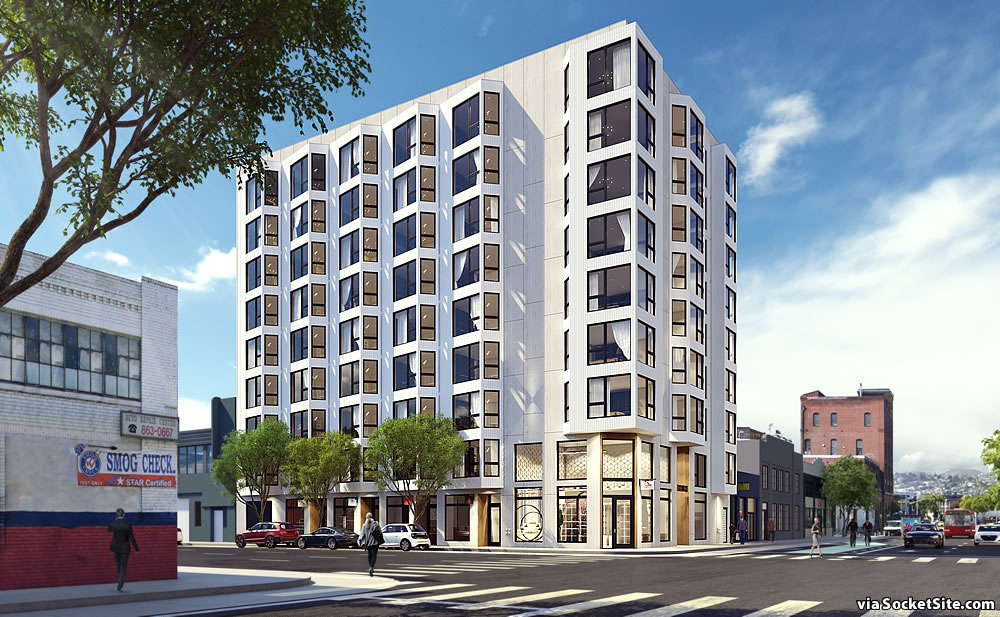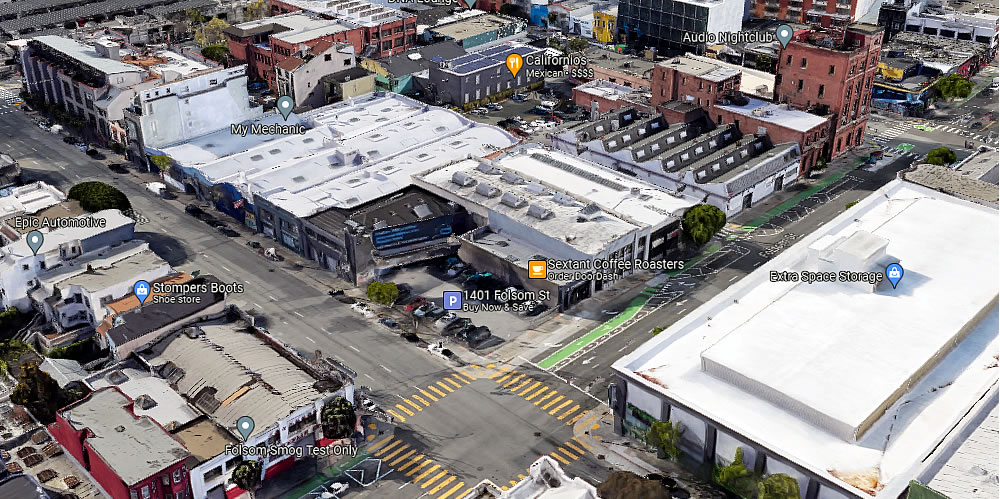Acquired for $3.25 million last year, plans for a supersized 9-story building to rise on the Western SoMA parking lot parcel on the southwest corner of Folsom and 10th Street, adjacent to Sextant Coffee Roasters, have been drawn.
While the corner parcel is currently only zoned for development up to 55 feet in height, the infill building would rise to a height of 85 feet and yield 94 modern Single Room Occupancy (SRO) units, along with 1,900 square feet of ground floor retail space, as designed and rendered by RG-Architecture, leveraging a density bonus for the additional height and density as proposed.
Building permits for the development have already been requested as well. We’ll keep you posted and plugged-in.


That looks great, I worked a block away from there and that neighborhood could use some additional residents
Are these “modern Single Room Occupancy (SRO) units” intended for low-income/elderly/disadvantaged residents, or are they more “market-rate” mini sleeping chambers for well-compensated but soon to be unemployed and/or geographically-distant user interface stylists? If the former, ok, even though it hurts to lose even more potential/actual light industrial space; if the latter, considering the currently hundreds, possibly thousands, and daily-increasing number of empty “market rate” coder pods in SOMA, with no end in sight, w the actual f?
Well you are certainly keeping the “user interface stylist coders” employed.
It’s a parking lot.
Yes, that’s obvious, and that fact neither answers my questions nor refutes the need to intelligently plan land use for future business, labor, housing, environmental, and other related economic contingencies. But if someone can get rich quick now as a tradeoff for worse future living conditions, who gives a f, right?
The underlying idea of a market based housing economy is that individual self-interested actors will do a better job satisfying the marked need for housing than consolidating all housing production in the hands of a single actor. Of course things like interest rates, tariffs, labor costs, and zoning exert major pressure on these actors and distort the results, and profit isn’t sufficiently motivating to address the bottom of the market.
But we’ve seen what happens when we consolidate power over all housing in a single political body: institutional paralysis. San Francisco hasn’t built nearly enough housing because the ones who control the housing spigot have to answer to some very loud voices whose desires are explicitly counter to housing production. On the one hand, entrenched owners demand preservation of views, or “neighborhood character”, or property values. On the other hand, activists decry any housing project that dare pursue a profit at the prevailing market rate.
The best laid plans o’ mice and men gang aft agley. We’d get more housing built, which is itself the desired long term outcome, if we planned less, not more, and increased the flexibility to react to evolving conditions. We can and should address the unprofitable segment of the housing market by creating actors which are not profit-incentivized, not by trying to criminalize profit-seeking in the first place.
They’ll get it entitled then put it back on the market. Next.
I don’t think building permits are typically requested in that case.
every new building in Western Soma should be this heights. it is massively underzoned
100% agree. Luckily state bonuses made the height limits obsolete.
On Craigslist there are about 8,000 units available for rent in SF when I checked last month. Asking a genuine question if we really need more housing with so many units available.
I don’t understand the need for SRO’s. Will these be for sale or rent (or just mapped as condos for future flexibility)?
You can think of it as kinda like bait and switch.
Developers propose SROs and people think the ultimate residents will be the working class, because in it’s past that’s how S.F. housed single working men. This is the bait.
But when SROs get built, the developers will fill up the building with people just out of college and young tech workers who don’t want to live with roomates, and that’s how the price of rental housing gets bid up. Landlords for other market rental housing do the math on how much people in the newly-built SRO are paying on a per ft.² basis for an SRO (which is more than a studio), and then say to themselves, “well, I am renting standard out standard-sized studios, so I’ll raise the rent I am charging accordingly.”
Meanwhile, the real estate agents and other assorted chain yankers in these comment threads will be banging the counter posting “if you add supply, the price goes down, didn’t you take Econ 101?” while prices rise.
Prices are falling.
Prices are falling because demand is being reduced, not because for-profit developers have added too much supply to the market. And demand is being reduced due to workers deciding to work remotely and thereby avoiding overpaying the flippers, developers, and other hangers-on in the S.F. real estate “game” for housing.
Prices are a function of both supply and demand.
Where are all the remote workers who decided not to buy in SF currently buying? Not two years ago, but currently? Prices must be going crazy there right now.
And the number of people in the labor force living in SF is at the same level as Spring 2019 and Spring 2022. I wonder if the current housing price trends might be driven by something other than people fleeing SF to the places you’re going to name to work remotely?
That’s right. Price is determined by supply AND demand.
Developers and corporate landlords want tenants with jobs and the ability to pay the rent. Theoretically, these will free up the tenderloin tenements for those who need lower rents and don’t have ideal credit histories.
In fact, it’s not even theoretical. There’s a lot of empirical evidence that new housing, even luxury housing, lowers rental prices in the surrounding area. It isn’t just Econ 101, it’s science.
Yadda, yadda, yadda and more lanes on the freeway reduce traffic. Trickle down economics has always been a lie.
Neither adding freeways (induced demand) nor increasing luxury supply (adding links to the migration chain) are “trickle down economics”. Trickle-down economics would be the theory the builders of luxury units will spend their profits on luxury goods, the profits of which will be spent on wages to satisfy the increased demand, and that as this process repeats the result will be an increase in wealth at all levels. It’s a much different and empirically disproven theory, unlike demand induced by oversupply and substitution of inferior goods in the face of supply constraints, both of which have been proven in this very city.
I wish people would stop (intentionally?) mis-using “trickle down economics” to apply to the housing conversation. Trickle-down economics refers to a discredited Reagan-era idea that lowering taxes on the rich will cause economic benefits to “trickle-down” to the rest of the economy. It has nothing whatsoever to do with this conversation.
You think agents are banging the counters demanding more rentals?
Brahma (incensed renter),
Why do you — or anybody else for that matter — feel that they have the right to determine who should (or should not) live in any particular type of housing or in any particular neighborhood?
A large number of those units are surely bedrooms (not apartments or homes) and can’t satisfy the needs of the housing market as a whole. It also doesn’t consider that there may be far more people looking and/or shuffling around between apartments etc.
The quantity of listings itself isn’t the best indicator of market needs let alone what renters aspire to.
Where is the “Supersized” part of this development? Does a 9-story residential building in SOMA really deserve such a superlative?
The super size is relative to the zoned height:
“…the corner parcel is currently only zoned for development up to 55 feet in height…”
I like the design. How are SRO’S different from studios? Do they not have kitchens? Or do they have common bathrooms?
Studios can be built with full kitchens, including ovens and full-sized ranges, SRO units cannot.